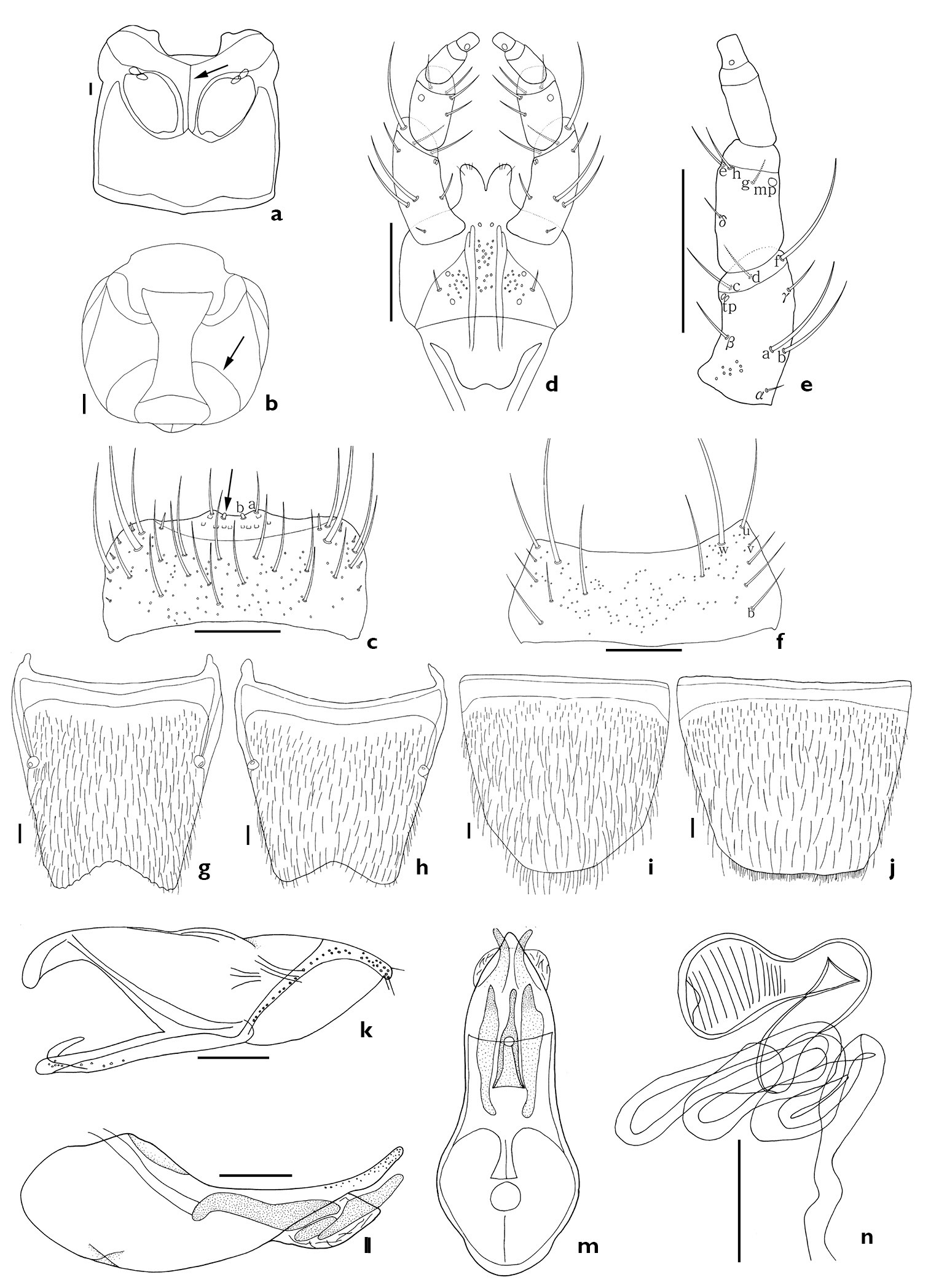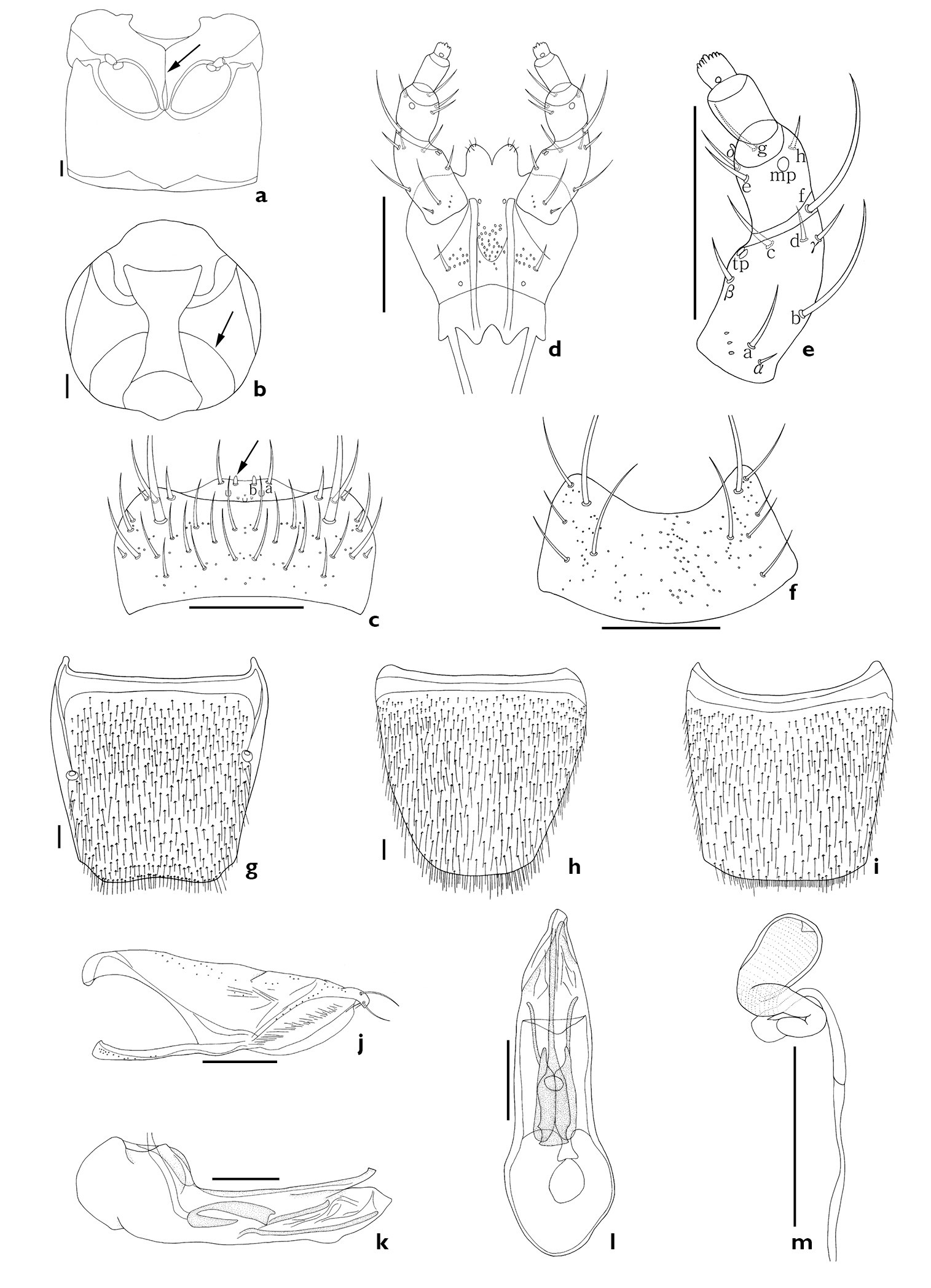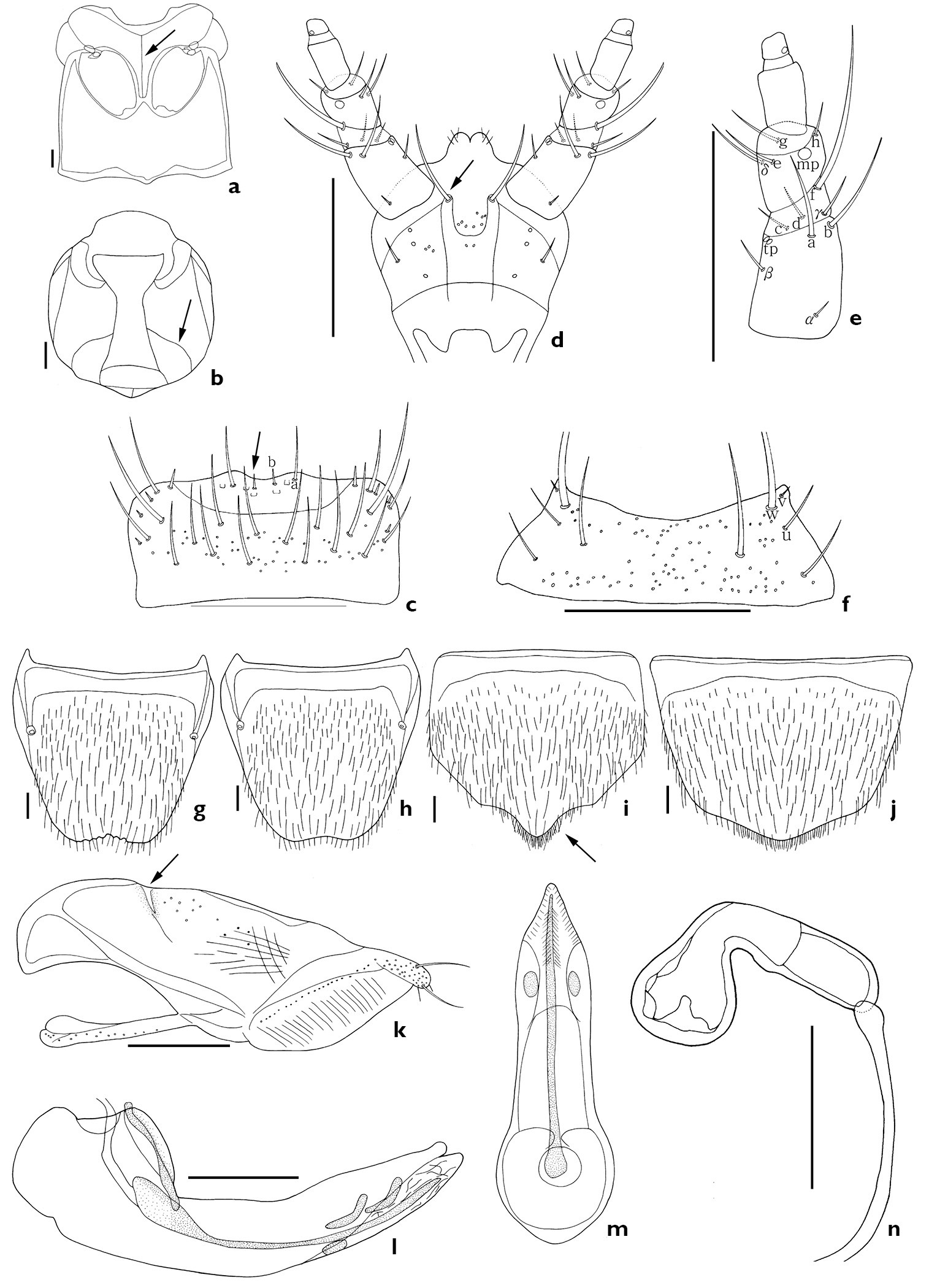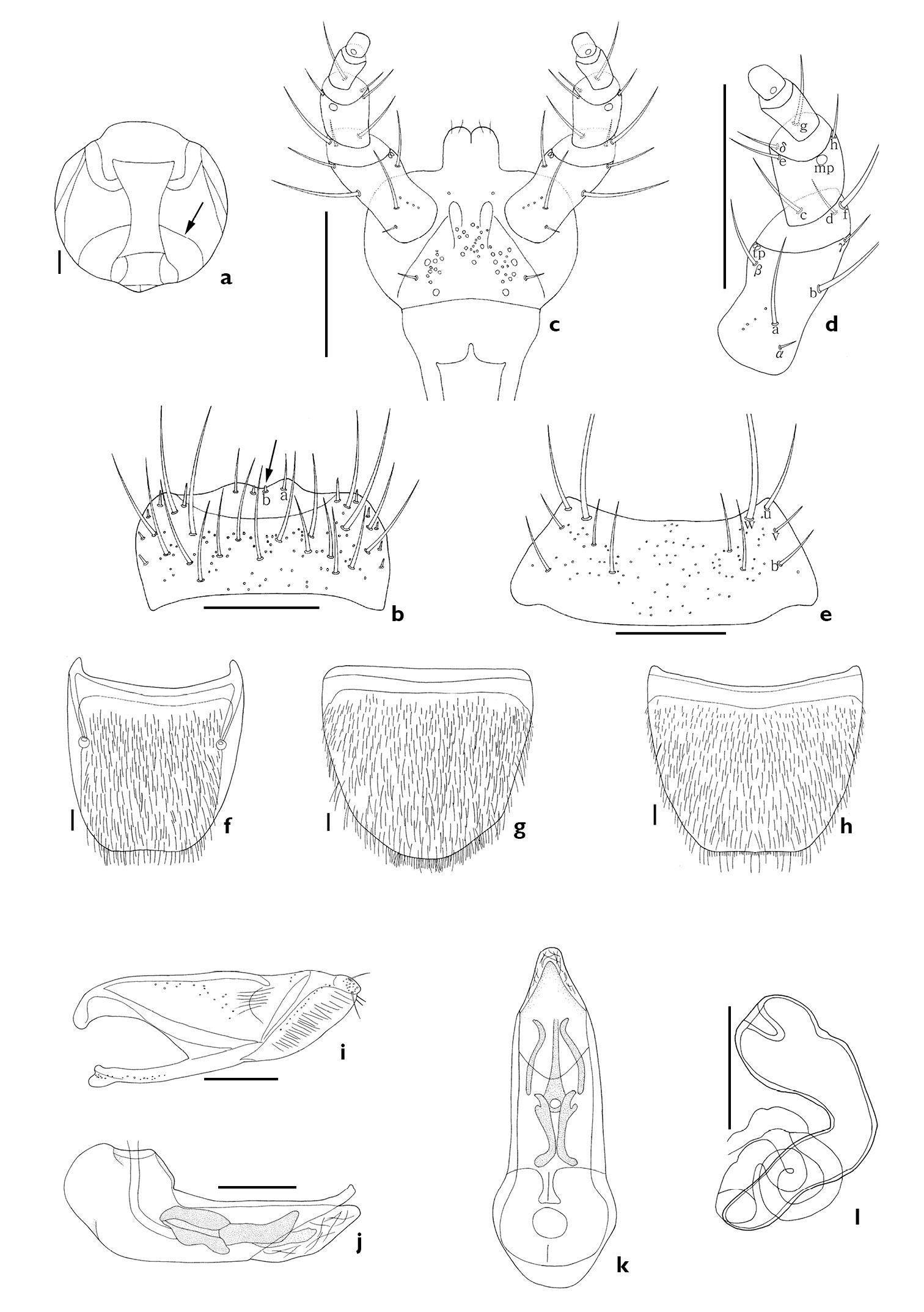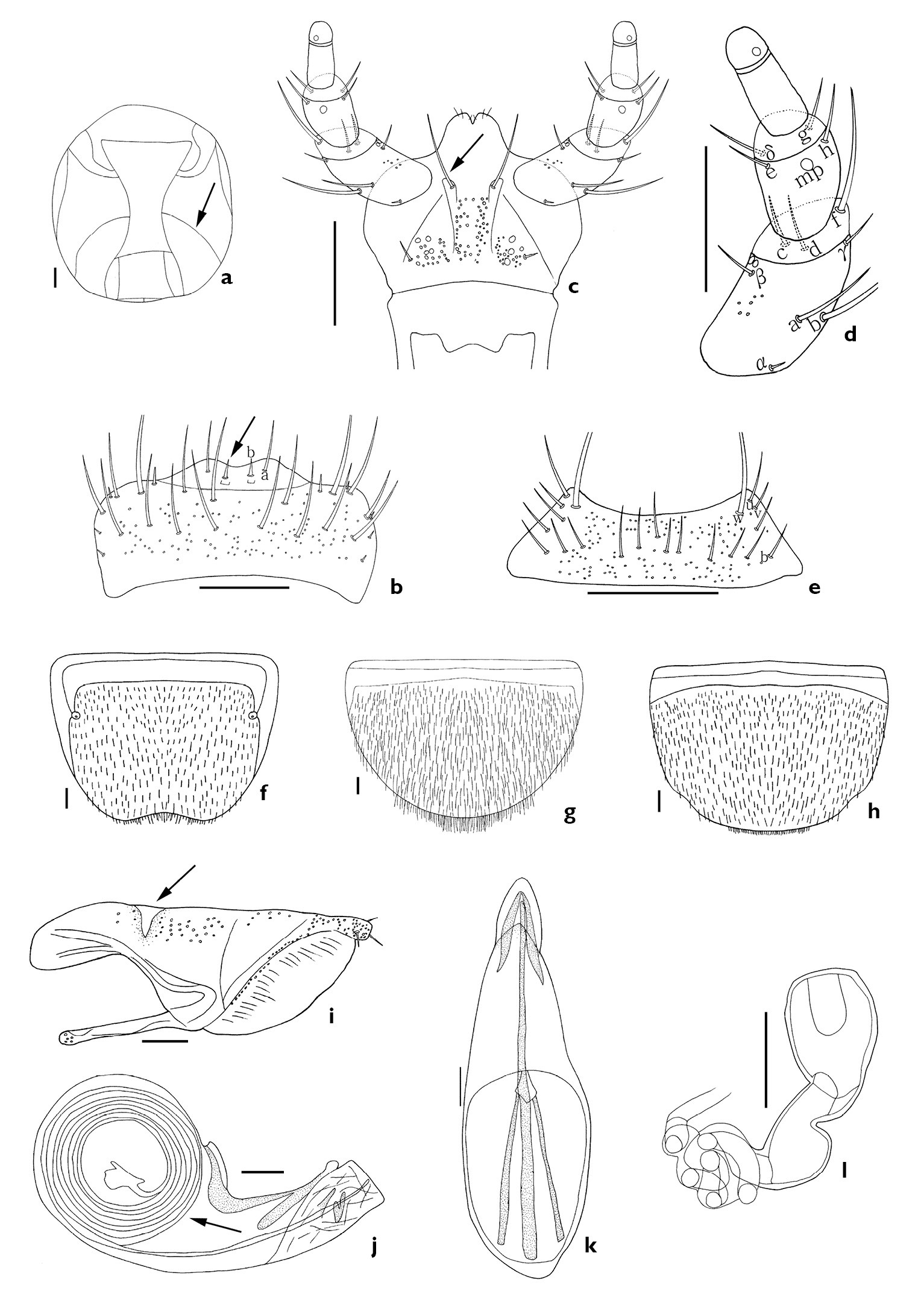(C) 2010 Jong-Seok Park. This is an open access article distributed under the terms of the Creative Commons Attribution License, which permits unrestricted use, distribution, and reproduction in any medium, provided the original author and source are credited.
For reference, use of the paginated PDF or printed version of this article is recommended.
A taxonomic review of Aleochara Gravenhorst subgenus Xenochara Mulsant & Rey in Korea is presented. Five species are recognized, with one species, Aleochara (Baryodma) intricata Mannerheim, newly transferred to the subgenus Xenochara. Aleochara (Xenochara) asiatica Kraatz and Aleochara (Xenochara) peninsulae Bernhauer are reported for the first time in the Korean peninsula. A key, line drawings of diagnostic characters, and redescriptions of Korean Xenochara species are provided.
Aleocharini, Aleochara, Xenochara, redescription, Korea
The staphylinid genus Aleochara
Gravenhorst includes over 400 species in 19 subgenera worldwide.
Fourteen species in six subgenera are recorded in the Korean peninsula (
Therefore, we used characters that are more informative
at the subgeneric and species levels. Our character analysis follows the
methods of
We redescribe five Korean Xenochara species herein, and a key and line drawings of diagnostic characters of these species are also provided. The Korean specimens studied are deposited in the Chungnam National University Insect Collection (CNUIC), Daejeon, Korea.
TaxonomyAleochara decorata Aubé.
. The subgenus Xenochara
can be distinguished by a combination of the following characters: body
compact, robust, pubescent; antennomere 4 usually longer than wide
(except Aleochara tristis,
transverse); carina on each side of midline of ventral surface of head
present, attaining or almost attaining gular suture (arrows, Figs 1b, 2b, 3b, 4a, 5a;
. This diagnosis is modified from
| 1. | Elytra with emarginate latero-posterior margins | 2 |
| – | Elytra with rounded latero-posterior margins | 3 |
| 2. | Labral b-seta acute (arrow, Fig. 3c), labium with a pair of distal setae (arrow, Fig. 3d), male abdominal tergite VIII with undulate posterior margin (secondary sexual dimorphism; Fig. 3g), male abdominal sternite VIII with produced posterior margin (secondary sexual dimorphism; arrow, Fig. 3i), paramere with fovea in hinge zone (arrow, Fig. 3k), spermathecal duct not coiled (Fig. 3n) | Aleochara peninsulae Bernhauer |
| – | Labral b-seta rounded at tip (arrow, Fig. 4b), labium without distal setae (Fig. 4c), male abdominal tergite VIII without undulate posterior margin (Fig. 4f), male abdominal sternite VIII with rounded posterior margin (Fig. 4g), paramere without fovea in hinge zone (Fig. 4j), spermathecal duct coiled (Fig. 4l) | Aleochara puberula Klug |
| 3. | Antennomeres 5–6 longer than wide, abdominal tergite VIII with deeply emarginate posterior margin (Figs 1g, 1h), male tergite VIII with undulate posterior margin (secondary sexual dimorphism; Fig. 1g) | Aleochara asiatica Kraatz |
| – | Antennomeres 5–6 transverse, abdominal tergite VIII with weakly emarginate posterior margin (Figs 2g, 5f), male tergite VIII without undulate posterior margin (Figs 2g, 5f) | 4 |
| 4. | Antennomere 4 longer than wide, labral b-seta rounded at tip (arrow, Fig. 2c), labium without distal setae (Fig. 2d), paramere without fovea in hinge zone (Fig. 2j), median lobe without coiled flagellum (Fig. 2k), spermathecal duct not coiled (Fig. 2m) | Aleochara intricata Mannerheim |
| – | Antennomere 4 transverse, labral b-seta acute (arrow, Fig. 5b), labium with a pair of distal setae (arrow, Fig. 5c), paramere with fovea in hinge zone (arrow, Fig. 5i), median lobe with coiled flagellum (arrow, Fig. 5j), spermathecal duct coiled (Fig. 5l) | Aleochara tristis Gravenhorst |
See
Fig. 1
. Length 4.5–6.5 mm. Body large and robust; brownish black, antenna and legs black; elytra bicolored. Antennomeres 1–3 elongate, 4–6 longer than wide and 7–10 transverse. Mouthparts. Labrum transverse, bearing approximately 11 small, setae, and approximately 21 long setae, a-seta, b-seta, and pores present; b-seta rounded apically (arrow indicates b-seta, Fig. 1c). Labium with pseudopores in median area, approximately 2 real pores and pseudopores present in lateral area; a pair of basal pores present (Fig. 1d). Ligula with approximately 4 pairs of small setae apically (Fig. 1d). Labial palpi with large a-, b-, and f-seta of 12 setae present (a–h, α–δ); long β-seta present in the middle of palpomere 1; d-seta higher than c-seta (Fig. 1e). Mentum transverse, bearing 4 pairs of main setae (b, u, v, w), and 6 extra setae, and pores present (Fig. 1f). Thorax. Mesoventrite completely carinate (arrow, Fig. 1a). Elytra with round latero-posterior margin. Abdomen. Male and female abdominal tergite VIII with many short setae and pores; posterior margin deeply emarginate and undulate on male (Fig. 1g, h). Male and female abdominal sternite VIII with many short setae and pores, margin rounded and female with many small setae on posterior margin (Fig. 1i, j). Genitalia. Median lobe as in Figs 1l and m. Paramere without fovea in hinge zone (Fig. 1k). Spermatheca with duct coiled (Fig. 1n).
Aleochara (Xenochara) asiatica. a meso- and metaventrite, ventral aspect b head, ventral aspect c labrum, dorsal aspect d labium, ventral aspect e labial palpus, ventral aspect f mentum, ventral aspect g male tergite VIII, dorsal aspect h female tergite VIII, dorsal aspect i male sternite VIII, ventral aspect j female sternite VIII, ventral aspect k paramere, lateral aspect l median lobe, lateral aspect m median lobe, dorsal aspect n spermatheca. Scale bars = 0.1 mm.
. 1♂, Daeheungsa-temple, Samsan-myeon, Haenam-gun, Jeonnam Prov., Korea, 23.IV.1983, Y. B. Cho; 4♂♂ 2♀♀, Jeju Prov., Korea, 22.VII.1985, Y.B. Cho (1♂ 1♀, on slide); 1♀, Donnaeko, Sanghyo-dong, Seogwipo-city, Jeju Prov., Korea, 18.X.1985, K.-S. Lee; 1♀, Donnaeko, Sanghyo-dong, Seogwipo-city, Jeju Prov., Korea, 22.X.1985, K.-S. Lee; 1♀, Jeongbangpolpo-waterfall, Donghong-dong, Seogwipo-city, Jeju Prov., Korea, 29.X.1985, K.-S. Lee; 1♂, Gasi-ri, Pyoseon-myeon, Namjeju-gun, Jeju Prov., Korea, 5.V.1985, K.-S. Lee; 2, Japan, G. Lewis, 1910–320, Nagasaki, 22.V–3.VI.81; 2, Japan, G. Lewis, 1910–320, Kumamoto, 23.IV–26.IV.81; 3, Japan, G. Lewis, 1905–313 (1, Holotype of Aleochara japonica Sharp, deposited in the Natural History Museum, London); 1, Japan, G. Lewis, 1910–320.
. China, India, Japan, Korea, Nepal, Taiwan (see Smetana, 2004: 356).
. This species is a new record for the Korean peninsula.
Fig. 2
. Length 3.5–6.0 mm. Body large and robust; brownish black; antennomeres 1–3 and legs brown; elytra yellow to yellowish brown and bicolored. Antennomeres 1–3 elongate, 4 longer than wide, 5–8 weakly transverse and 9–10 transverse. Mouthparts. Labrum transverse, bearing approximately 8 small, setae, and approximately 26 long setae, a-seta, b-seta, and pores present; b-seta rounded apically (arrow indicates b-seta, Fig. 2c). Labium with pseudopores in median area; approximately 3 real pores and pseudopores present in lateral area; pair of basal pores present (Fig. 2d). Ligula with approximately 4 pairs of small setae apically (Fig. 2d). Labial palpi with large a-, b-, and f-seta of 12 setae (a–h, α–δ) present; β-seta close to twin pores (tp); d- and c-seta at same level (Fig. 2e). Mentum transverse, bearing 4 pairs of main setae (b, u, v, w), and 4 extra setae, and pores present (Fig. 2f). Thorax. Mesoventrite completely carinate (arrow, Fig. 2a). Elytra with round latero-posterior margin. Abdomen. Abdominal tergite VIII with many short setae and pores; posterior margin weakly emarginate (Fig. 2g). Abdominal sternite VIII with many short setae and pores; posterior margin rounded (Fig. 2h, i). Genitalia. Median lobe as in Figs 2k and l. Paramere without fovea in hinge zone (Fig. 2j). Spermatheca as in Fig. 2m.
Aleochara (Xenochara) intricata. a meso- and metaventrite, ventral aspect b head, ventral aspect c labrum, dorsal aspect d labium, ventral aspect e labial palpus, ventral aspect f mentum, ventral aspect g tergite VIII, dorsal aspect h male sternite VIII, ventral aspect i female sternite VIII, ventral aspect j paramere, lateral aspect k median lobe, lateral aspect l median lobe, dorsal aspect m spermatheca. Scale bars = 0.1 mm.
. 7, Hol-ri, Ganseong-eup, Goseong-gun, Gangwon Prov., Korea, 31.VIII–1.IX.1984, Y.-S. Kim (2♂♂2♀♀, on slide); 1, Gohan-ri, Sabuk-eup, Gangwon Prov., Korea, 27.IV.1985, J.-I. Kim; 1, Deakwan-ryeong, Gangwon Prov., Korea, 28.VI.1984, Y.-S. Kim; 2, Oigapyeong, Inje-gun, Gangwon Prov., Korea, 26.V.1986, Y.-S. Kim; 1, Baekdamsa-temple, Inje-gun, Gangwon Prov., Korea, 26.V.1986, Y.-S. Kim; 1, Dammaeul, Cheongsong, Gyeongbuk Prov., Korea, 24.VI.1988, K.-S. Jang; 1, Tonghan, Anjeong, Jeonbuk Prov., Korea, 5.VI.1988, Y.-S. Kim; 6, Seilles, carriere 1, 11/19 VIII 1945, G. Fagel; 2, Anseremme car, vers Freyr, 26 VIII 1946, G. Fagel; 2, Abruzzo, A. colomba, Italy, 26.VII.1894, P Fiori; 12, Lazio, Roma, Lirezzi, Italy, A. Fiori.
. Korea, Asia, Europe, North Africa (see Smetana, 2004: 354).
. This species is a new record for South Korea.
Fig. 3
. Male mounted on card, with mouthparts, aedeagus and abdominal apex (segment VIII+) mounted in balsam on two transparent cards, labeled as follows: “Shimabara Unzen 2200F 2. 8. 34. Suenson” [printed]; “peninsulae Brnh. Typus un. Polychara” [handwritten yellow label]; “peninsulae Brnh. Typus unic.” [handwritten white label]; “Chicago NHMus M. Bernhauer Collection” [printed]; “HOLOTYPE Aleochara peninsulae Bernhauer, 1936 teste Park & Ahn 2007” . Deposited in the Field Museum of Natural History (FMNH), Chicago, USA.
. Length 3.8–5.4 mm. Body compact and robust; reddish black; antenna, elytra, and legs brownish black; elytra bicolored. Antennomeres 1–3 elongate, 4 longer than wide, 5 subquadrate, and 6–10 transverse. Mouthparts. Labrum transverse, bearing approximately 8 small, setae, and approximately 19 long setae, a-seta, b-seta and pores present; b-seta acute (arrow indicates b-seta, Fig. 3c). Labium with pseudopores in median area; approximately 3 pores and pseudopores present in lateral area; a pair of distal setae present (arrow indicates distal seta, Fig. 3d). Ligula with approximately 3 pairs of small setae apically (Fig. 3d). Labial palpi with large a-, b-, and f-seta of 12 setae present (a–h, α–δ); β-seta close to twin pores (tp); d-seta higher than c-seta (Fig. 3e). Mentum transverse, bearing 4 pairs of main setae (b, u, v, w), and approximately 2 extra setae, and pores present (Fig. 3f). Thorax. Mesoventrite completely carinate (arrow, Fig. 3a). Elytral latero-posterior margin emarginate. Abdomen. Abdominal tergite VIII with many short setae and pores; posterior margin emarginate; undulate on male (Fig. 3g, h). Male abdominal sternite VIII with many short setae and pores; posterior margin produced on male (arrow, Fig. 3i) and rounded on female (Fig. 3j). Genitalia. Median lobe as in Figs 3l and m. Paramere with fovea in hinge zone (arrow, Fig. 3k). Spermatheca as in Fig. 3n.
Aleochara (Xenochara) peninsulae. a meso- and metaventrite, ventral aspect b head, ventral aspect c labrum, dorsal aspect d labium, ventral aspect e labial palpus, ventral aspect f mentum, ventral aspect g male tergite VIII, dorsal aspect h female tergite VIII, dorsal aspect i male sternite VIII, ventral aspect j female sternite VIII, ventral aspect k paramere, lateral aspect l median lobe, lateral aspect m median lobe, dorsal aspect n spermatheca. Scale bars = 0.1 mm.
. 2, Gyeongsang Univ., Gajoa-Dong, Jinju-city, Gyeongnam Prov., Korea, 26.III.2003, C.-S. Lim, ex bait trap; 2, Gyeongsang Univ., Gajoa-Dong, Jinju-city, Gyeongnam Prov., Korea, 2 VI 2003, C.-S. Lim, ex bait trap; 1, Gyeongsang Univ., Gajoa-Dong, Jinju-city, Gyeongnam Prov., Korea, 27.III.2003, C.-S. Lim, ex bait trap; 2, Gyeongsang Univ., Gajoa-Dong, Jinju-city, Gyeongnam Prov., Korea, 22.III.2003, C.-S. Lim, ex bait trap; 1, Gyeongsang Univ., Gajoa-Dong, Jinju-city, Gyeongnam Prov., Korea, 12.III.2003, C.-S. Lim, ex bait trap; 1, Gyeongsang Univ., Gajoa-Dong, Jinju-city, Gyeongnam Prov., Korea, 7.IV.2003, C.-S. Lim, ex bait trap; 1, Gyeongsang Univ., Gajoa-Dong, Jinju-city, Gyeongnam Prov., Korea, 15.III.2003, C.-S. Lim, ex bait trap; 1, Gyeongsang Univ., Gajoa-Dong, Jinju-city, Gyeongnam Prov., Korea, 24.III.2003, C.-S. Lim, ex bait trap; 1, Gyeongsang Univ., Gajoa-Dong, Jinju-city, Gyeongnam Prov., Korea, 29.V.2003, C.-S. Lim, ex bait trap; 1, Gyeongsang Univ., Gajoa-Dong, Jinju-city, Gyeongnam Prov., Korea, 30.III.2003, C.-S. Lim, ex bait trap; 1, near 1100m Rest Area, Jeju Prov., Korea, 30.V–17.VI.2003, Y.-B. Cho, ex bait trap.
. Japan, Korea.
. This species is a new record for the Korean peninsula.
Fig. 4
. Length 3.5–5.5 mm. Body reddish brown; antennomeres 1–3, elytra, and legs brown; elytra bicolored. Antennomeres 1–3 elongate, 4 longer than wide, 5 subquadrate, and 6–10 transverse. Mouthparts. Labrum transverse, bearing approximately 11 small, setae, and approximately 19 long setae, a-seta, b-seta, and pores present; b-seta rounded at tip (arrow indicates b-seta, Fig. 4b). Labium with pseudopores in median area; approximately 3 real pores and pseudopores present in lateral area; a pair of basal pores present (Fig. 4c). Ligula with approximately 2 pairs of small setae apically (Fig. 4c). Labial palpi with large a-, b-, and f-seta of 12 setae present (a–h, α–δ); β-seta close to twin pores (tp); c-seta higher than d-seta (Fig. 4d). Mentum transverse, bearing 4 pairs of main setae (b, u, v, w), and 4 extra setae, and pores present (Fig. 4e). Thorax. Elytral latero-posterior margin emarginate. Abdomen. Abdominal tergite VIII with many short setae and pores; posterior margin weakly emarginate (Fig. 4f). Abdominal sternite VIII with many short setae and pores; apical margin rounded on male (Fig. 4g) and truncated on female (Fig. 4h). Genitalia. Median lobe as in Figs 4j and k. Paramere with fovea absent in hinge zone (Fig. 4i). Spermatheca coiled in duct (Fig. 4l).
Aleochara (Xenochara) puberula. a head, ventral aspect b labrum, dorsal aspect c labium, ventral aspect d labial palpus, ventral aspect e mentum, ventral aspect f tergite VIII, dorsal aspect g male sternite VIII, ventral aspect h female sternite VIII, ventral aspect i paramere, lateral aspect j median lobe, lateral aspect k median lobe, dorsal aspect l spermatheca. Scale bars = 0.1 mm.
. 2, Seoguipo-city, Jeju Prov., Korea, 18.VI.1985, K.-S. Lee; 1, Anseong, Muju-gun, Jeonbuk Prov., Korea, 5.VI.1988, G.-S. Jang; 22, Reunion 22–23.I.1992, Ravine de St. Gilles Bassin Cormoran, J. Janaj lgt; 1, Philippinen, Manila, Luy, 2.XI.1914; 1, Argentina, Prov. Tucuman, 450m, I 1905, Steinbach; 1, N. Palawan, Bakuit, 12.XI–22.XII 1913, Bottcher; 4, Sud algérien: Mrhaier 120 Km S de Biskra, 14.V.1954, G. Fagel; 4, China, B. M. 1980–491, P. M. Hammond, Guangdong, Guangzhou, Baiyunshan, 27.IX.80; 4, China, B. M. 1980–491, P. M. Hammond, Guizhou, 20m, S. Guilin, 22.IX.80; 1, Japan, Honshu, B. M. 1980–492, P. M. Hammond, Nara, ft of Mt. Kasuga, 20.VIII.80; 2, Japan, Sharp Coll., 1905–313; 4, Japan, G. Lewis, 1910–320.
. Japan, Korea, Asia, Europe, North Africa, North America (see Smetana, 2004: 360).
See
Fig. 5
. Length 3.7–6.4 mm. Body black; antenna and legs reddish black; elytra yellow to yellowish brown and bicolored. Antennomeres 1–3 elongate, and 4–10 transverse. Mouthparts. Labrum transverse, bearing approximately 9 small, setae, and approximately 17 long setae, a-seta, b-seta, and pores resent; b-seta acute (arrow indicates b-seta, Fig. 5b). Labium with pseudopores in median area; about 3 real pores and pseudopores present in lateral area; a pair of distal setae present (arrow indicates distal seta, Fig. 5c). Ligula with approximately 3 pairs of small setae apically (Fig. 5c). Labial palpi with large a-, b-, and f-seta of 12 setae present (a–h, α–δ); β-seta close to twin pores (tp); c- and d-seta same level (Fig. 5d). Mentum transverse, bearing 4 pairs of main setae (b, u, v, w), and 13 extra setae, and pores present (Fig. 5e). Thorax. Elytra with round latero-posterior margin. Abdomen. Abdominal tergite VIII with many short setae and pores; posterior margin emarginate (Fig. 5f). Abdominal sternite VIII with many short setae and pores; apical margin rounded (Fig. 5g, h). Genitalia. Median lobe with coiled flagellum (arrow, Figs 5j and k). Paramere with fovea in hinge zone (arrow, Fig. 5i). Spermathecal duct coiled (Fig. 5l).
Aleochara (Xenochara) tristis. a head, ventral aspect b labrum, dorsal aspect c labium, ventral aspect d labial palpus, ventral aspect e mentum, ventral aspect f tergite VIII, dorsal aspect g male sternite VIII, ventral aspect h female sternite VIII, ventral aspect i paramere, lateral aspect j median lobe, lateral aspect k median lobe, dorsal aspect l spermatheca. Scale bars = 0.1 mm.
. 1, Russia, Tadshikistan, 1981, Duechanbe env, on light, 16–18.VI.1981, K. Majer; 36, Russia, Tadshikistan, Umg. Duechanbe env, 800–1200m, 4–14.IX.1983, U. Arnold.
. Korea, Asia, Europe, North Africa, North America (see Smetana, 2004: 361).
. See
See
We thank Mr. James H. Boone and Dr. Alfred F. Newton (FMNH, Chicago) for the loan of type specimen and encouragements. We also thank Chris Carlton, Matthew Gimmel (Louisiana State Univ., Baton Rouge), and anonymous reviewers for helpful comments. This publication was approved by the Director, Louisiana Agricultural Experiment Station as manuscript number 2010-234-4180. This research was supported by the project on survey and excavation of Korean indigenous species of the National Institute of Biological Resources (NIBR) under the Ministry of Environment, Korea.







